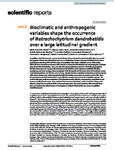Bioclimatic and anthropogenic variables shape the occurrence of Batrachochytrium dendrobatidis over a large latitudinal gradient
| dc.contributor.author | Alvarado-Rybak, M | |
| dc.contributor.author | Lepe-Lopez, M | |
| dc.contributor.author | Peñafiel-Ricaurte, A | |
| dc.contributor.author | Valenzuela-Sánchez, A | |
| dc.contributor.author | Valdivia, C | |
| dc.contributor.author | Mardones, FO | |
| dc.contributor.author | Bacigalupe, LD | |
| dc.contributor.author | Puschendorf, Robert | |
| dc.contributor.author | Cunningham, AA | |
| dc.contributor.author | Azat, C | |
| dc.date.accessioned | 2021-09-03T14:00:38Z | |
| dc.date.available | 2021-09-03T14:00:38Z | |
| dc.date.issued | 2021-12 | |
| dc.identifier.issn | 2045-2322 | |
| dc.identifier.issn | 2045-2322 | |
| dc.identifier.other | 17383 | |
| dc.identifier.uri | http://hdl.handle.net/10026.1/17758 | |
| dc.description.abstract |
<jats:title>Abstract</jats:title><jats:p>Amphibian chytridiomycosis, caused by the fungus <jats:italic>Batrachochytrium dendrobatidis</jats:italic> (<jats:italic>Bd</jats:italic>), has caused the greatest known loss of biodiversity due to an infectious disease. We used <jats:italic>Bd</jats:italic> infection data from quantitative real-time PCR (qPCR) assays of amphibian skin swabs collected across Chile during 2008–2018 to model <jats:italic>Bd</jats:italic> occurrence with the aim to determine bioclimatic and anthropogenic variables associated with <jats:italic>Bd</jats:italic> infection. Also, we used <jats:italic>Bd</jats:italic> presence/absence records to identify geographical <jats:italic>Bd</jats:italic> high-risk areas and compare <jats:italic>Bd</jats:italic> prevalence and infection loads between amphibian families, ecoregions, and host ecology. Data comprised 4155 <jats:italic>Bd</jats:italic>-specific qPCR assays from 162 locations across a latitudinal gradient of 3700 km (18º to 51ºS). Results showed a significant clustering of <jats:italic>Bd</jats:italic> associated with urban centres and anthropogenically highly disturbed ecosystems in central-south Chile. Both <jats:italic>Bd</jats:italic> prevalence and <jats:italic>Bd</jats:italic> infection loads were higher in aquatic than terrestrial amphibian species. Our model indicated positive associations of <jats:italic>Bd</jats:italic> prevalence with altitude, temperature, precipitation and human-modified landscapes. Also, we found that macroscale drivers, such as land use change and climate, shape the occurrence of <jats:italic>Bd</jats:italic> at the landscape level. Our study provides with new evidence that can improve the effectiveness of strategies to mitigate biodiversity loss due to amphibian chytridiomycosis.</jats:p> | |
| dc.format.extent | 17383- | |
| dc.format.medium | Electronic | |
| dc.language | en | |
| dc.language.iso | en | |
| dc.publisher | Nature Research (part of Springer Nature) | |
| dc.subject | Altitude | |
| dc.subject | Amphibians | |
| dc.subject | Animals | |
| dc.subject | Batrachochytrium | |
| dc.subject | Chile | |
| dc.subject | DNA, Fungal | |
| dc.subject | Ecosystem | |
| dc.subject | Linear Models | |
| dc.subject | Mycoses | |
| dc.subject | Prevalence | |
| dc.subject | Real-Time Polymerase Chain Reaction | |
| dc.subject | Spatial Analysis | |
| dc.subject | Temperature | |
| dc.title | Bioclimatic and anthropogenic variables shape the occurrence of Batrachochytrium dendrobatidis over a large latitudinal gradient | |
| dc.type | journal-article | |
| dc.type | Journal Article | |
| dc.type | Research Support, Non-U.S. Gov't | |
| plymouth.author-url | https://www.webofscience.com/api/gateway?GWVersion=2&SrcApp=PARTNER_APP&SrcAuth=LinksAMR&KeyUT=WOS:000693354000016&DestLinkType=FullRecord&DestApp=ALL_WOS&UsrCustomerID=11bb513d99f797142bcfeffcc58ea008 | |
| plymouth.issue | 1 | |
| plymouth.volume | 11 | |
| plymouth.publication-status | Published online | |
| plymouth.journal | Scientific Reports | |
| dc.identifier.doi | 10.1038/s41598-021-96535-w | |
| plymouth.organisational-group | /Plymouth | |
| plymouth.organisational-group | /Plymouth/Faculty of Science and Engineering | |
| plymouth.organisational-group | /Plymouth/Faculty of Science and Engineering/School of Biological and Marine Sciences | |
| plymouth.organisational-group | /Plymouth/REF 2021 Researchers by UoA | |
| plymouth.organisational-group | /Plymouth/REF 2021 Researchers by UoA/UoA06 Agriculture, Veterinary and Food Science | |
| plymouth.organisational-group | /Plymouth/Users by role | |
| plymouth.organisational-group | /Plymouth/Users by role/Academics | |
| dc.publisher.place | England | |
| dcterms.dateAccepted | 2021-08-05 | |
| dc.rights.embargodate | 2021-9-7 | |
| dc.identifier.eissn | 2045-2322 | |
| dc.rights.embargoperiod | Not known | |
| rioxxterms.versionofrecord | 10.1038/s41598-021-96535-w | |
| rioxxterms.licenseref.uri | http://www.rioxx.net/licenses/all-rights-reserved | |
| rioxxterms.licenseref.startdate | 2021-12 | |
| rioxxterms.type | Journal Article/Review |


